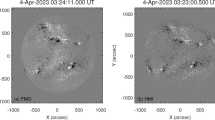Abstract
The Full-disk MagnetoGraph (FMG) onboard the Advanced Space based Solar Observatory has obtained a series of line-of-sight magnetic-field measurements since its launch in October 2022. It is important to compare its observational data with other existing solar telescopes. In this paper, we make a detailed comparison of four active regions and a pore region simultaneously observed by FMG, the Helioseismic and Magnetic Imager (HMI) onboard the Solar Dynamic Observatory, and the Solar Magnetism and Activity Telescope (SMAT) at Huairou Solar Observing Station. We find that the magnetic-field structure and spatial distribution are basically consistent among these three instruments. The initial correlation coefficient of magnetic field is approximately 0.90. The coefficient slightly increases when sunspot umbra regions are excluded, and it increases significantly up to 0.98 for the magnetic field in penumbra regions. The magnetic field observed by FMG tends to be weaker than the HMI in strength in sunspot umbra due to saturation effect, whereas larger outside sunspot. The differences are probably due to different noise levels, seeing conditions (SMAT is affected by the Earth’s atmosphere) and observational and calibration methods.










Similar content being viewed by others
Data Availability
The HMI data used in this paper is taken from http://jsoc.stanford.edu.
References
Ai, G.X., Li, W., Zhang, H.Q.: 1982, Acta Astron. Sin. 23, 39. ADS.
Demidov, M.L., Wang, X.F., Wang, D.G., Deng, Y.Y.: 2018, Solar Phys. 293, 146. DOI. ADS.
Deng, Y.Y., Zhang, H.Y., Yang, J.F., Li, F., Lin, J.B., Hou, J.F., et al.: 2019, Res. Astron. Astrophys. 19, 157. DOI. ADS.
Gan, W.Q., Zhu, C., Deng, Y.Y., Li, H., Su, Y., Zhang, H.Y., et al.: 2019, Res. Astron. Astrophys. 19, 156. DOI. ADS.
Gan, W.Q., Zhu, C., Deng, Y.Y., Zhang, Z., Chen, B., Huang, Y., et al.: 2023, Solar Phys. 298, 68. DOI. ADS.
Hayashi, K., Yang, S.B., Deng, Y.Y.: 2016, J. Geophys. Res. 121, 1046. DOI. ADS.
Hou, J.F., Wang, D.G., Deng, Y.Y., Zhang, Z.Y., Sun, Y.Z.: 2020, Chin. Phys. B 29, 124211. DOI. ADS.
Liu, Y., Hoeksema, J.T., Scherrer, P.H., Couvidat, S., Bush, R.I., Duvall, T.L., et al.: 2012, Solar Phys. 279, 295. DOI. ADS.
Liu, S., Su, J.T., Bai, X.Y., Deng, Y.Y., Chen, J., Song, Y.L., et al.: 2023, Solar Phys. 298, 141. DOI. ADS.
Scherrer, P.H., Bogart, R.S., Bush, R., Hoeksema, J.T., Kosovichev, A.G., Schou, J., et al.: 1995, Solar Phys. 162, 129. DOI. ADS.
Scherrer, P.H., Schou, J., Bush, R.I., Kosovichev, A.G., Bogart, R.S., Hoeksema, J.T., et al.: 2012, Solar Phys. 275, 207. DOI. ADS.
Schou, J., Scherrer, P.H., Bush, R.I., Wachter, R., Couvidat, S., Rabello-Soares, M.C., et al.: 2012, Solar Phys. 275, 229. DOI. ADS.
Sinjan, J., Calchetti, D., Hirzberger, J., Kahil, F., Valori, G., Solanki, S.K., et al.: 2023, Astron. Astrophys. 673, A31. DOI. ADS.
Solanki, S.K., del Toro Iniesta, J.C., Woch, J., Gandorfer, A., Hirzberger, J., Alvarez-Herrero, A., et al.: 2020, Astron. Astrophys. 642, A11. DOI. ADS.
Su, J.T., Zhang, H.Q.: 2007, Astrophys. J. 666, 559. DOI. ADS.
Su, J.T., Bai, X.Y., Chen, J., Guo, J.J., Liu, S., Wang, X.F., et al.: 2019, Res. Astron. Astrophys. 19, 161. DOI. ADS.
Xu, H.Q., Liu, S., Su, J.T., Deng, Y.Y., Plotnikov, A., Bai, X.Y., et al.: 2021, Res. Astron. Astrophys. 21, 67. DOI. ADS.
Zhang, H.Q., Wang, D.G., Deng, Y.Y., Hu, K.L., Su, J.T., Lin, J.B., et al.: 2007, Chin. J. Astron. Astrophys. 7, 281. DOI. ADS.
Acknowledgments
We are sincerely grateful to the anonymous reviewer whose comments helped us to significantly improve the article. We acknowledge the free data usage policy of HSOS/SMAT and SDO/HMI.
Funding
This work is supported by National Key R&D Program of China (Grant No. 2022YFF0503001, 2021YFA1600500, 2022YFF0503800), National Natural Science Foundation of China (Grant No. 12273059, 11427901, 12173049, 12073040, 12003051, 12373057), Beijing Natural Science Foundation (Grant No. 1222029), and the Strategic Priority Research Program of the Chinese Academy of Sciences (Grant No. XDB0560000). ASO-S mission is supported by the Strategic Priority Research Program on Space Science, the Chinese Academy of Sciences (Grant No. XDA15320000).
Author information
Authors and Affiliations
Contributions
H.Q. Xu and J.T. Su carried out this work and were responsible for the data analysis. S. Liu provided suggestions on FMG data processing and conducted the data alignment. Y.Y. Deng proposed the overall idea. S.B. Yang provided the SMAT data processing. X.Y. Bai, J. Chen, X.F. Wang, X. Yang, and Y.L. Song gave suggestions for discussion and paper revision. S. Idrees corrected the language. All authors reviewed the manuscript.
Corresponding authors
Ethics declarations
Competing interests
The authors declare no competing interests.
Additional information
Publisher’s Note
Springer Nature remains neutral with regard to jurisdictional claims in published maps and institutional affiliations.
Rights and permissions
Springer Nature or its licensor (e.g. a society or other partner) holds exclusive rights to this article under a publishing agreement with the author(s) or other rightsholder(s); author self-archiving of the accepted manuscript version of this article is solely governed by the terms of such publishing agreement and applicable law.
About this article
Cite this article
Xu, H., Su, J., Liu, S. et al. Comparison of Line-of-Sight Magnetic Field Observed by ASO-S/FMG, SDO/HMI and HSOS/SMAT. Sol Phys 299, 17 (2024). https://doi.org/10.1007/s11207-024-02260-8
Received:
Accepted:
Published:
DOI: https://doi.org/10.1007/s11207-024-02260-8




